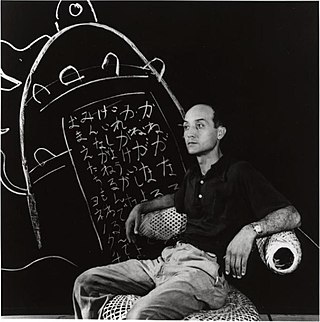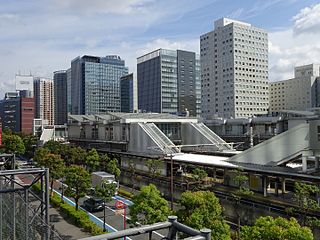
Isamu Noguchi was a Japanese American artist and landscape architect whose artistic career spanned six decades, from the 1920s onward. Known for his sculpture and public artworks, Noguchi also designed stage sets for various Martha Graham productions, and several mass-produced lamps and furniture pieces, some of which are still manufactured and sold.

Shinagawa is a special ward in Tokyo, Japan. The Ward refers to itself as Shinagawa City in English. The Ward is home to ten embassies.

Meguro is a special ward in Tokyo, Japan. The English translation of its Japanese self-designation is Meguro City. The ward was founded on March 15, 1947.

The Saikyō Line is a Japanese railway line operated by the East Japan Railway Company. It connects Ōsaki Station in Shinagawa, Tokyo, and Ōmiya Station in Saitama Prefecture. The line's name is an abbreviation of the two areas the line connects: Saitama (埼玉) and Tōkyō (東京).

Ōsaki Station is a railway station in Shinagawa, Tokyo, Japan, jointly operated by East Japan Railway Company and Tokyo Waterfront Area Rapid Transit (TWR).

Yayoi Kusama is a Japanese contemporary artist who works primarily in sculpture and installation, but is also active in painting, performance, film, fashion, poetry, fiction, and other arts. Her work is based in conceptual art and shows some attributes of feminism, minimalism, surrealism, Art Brut, pop art, and abstract expressionism, and is infused with autobiographical, psychological, and sexual content. She has been acknowledged as one of the most important living artists to come out of Japan.

The American School in Japan is an international private day school located in the city of Chōfu, Tokyo, Japan. The school consists of an elementary school, a middle school, and a high school, all located on the Chōfu campus. There is also an early learning center (nursery-kindergarten) for children aged 3–5 located in the Roppongi Hills complex in downtown Tokyo. Instruction is in English and follows an American-style curriculum. About two thirds of the school's students are the children of citizens of a wide variety of countries who are on temporary assignment in Japan, and the remaining one third are Japanese students who speak English. The campus is fenced in, resulting from heightened security measures taken after the September 11 attacks, with campus surroundings including the Nogawa Park and the neighborhood of Tama. The Good Schools Guide International called ASIJ "an impressive school, not only for its size and facilities but also for its strong sense of where it is going."

Washington Park is a public urban park in Portland in the U.S. state of Oregon. It includes a zoo, forestry museum, arboretum, children's museum, rose garden, Japanese garden, amphitheatre, memorials, archery range, tennis courts, soccer field, picnic areas, playgrounds, public art and many acres of wild forest with miles of trails.

Minoru Niizuma was a Japanese abstract sculptor.

Ingeborg Viktoria "Inge" King was a German-born Australian sculptor. She received many significant public commissions. Her work is held in public and private collections. Her best known work is Forward Surge (1974) at the Melbourne Arts Centre. She became a Member of the Order of Australia (AM) in January 1984.

Nasser Azam is a British contemporary artist, living and working in London.

Ōsaki (大崎) is a primarily commercial district in the northern part of Shinagawa, Tokyo, Japan. By today, this district has completed several urban renewal programs around Ōsaki Station of Yamanote Line, which include Ohsaki New City, Gate City Ohsaki (1999), Art Village Osaki (2007), Oval Court Ohsaki (2004), and ThinkPark (2007).

The Drop is a steel sculpture resembling a raindrop designed by the group of German artists known as Inges Idee, located at Bon Voyage Plaza in the Coal Harbour neighborhood of downtown Vancouver. The 65-foot (20 m) tall piece is covered with Styrofoam and blue polyurethane. According to Inges Idee, the sculpture is "an homage to the power of nature" and represents "the relationship and outlook towards the water that surrounds us". The Drop was commissioned as part of the 2009 Vancouver Convention Centre Art Project and is owned by BC Pavco.
Inges Idee is a German artist collective, formed in 1992, composed of Hans Hemmert, Axel Lieber, Thomas Schmidt, and George Zey.
Jae Ko is a Korean-born artist currently living and working on an island off the Western shore of Maryland.

Houston's Japanese Garden is a 5.5-acre (2.2 ha) Japanese garden in Hermann Park, in the U.S. state of Texas. The garden was designed by Tokyo landscape designer Ken Nakajima and opened in 1992.

The Eye of Shinjuku is a sculpture by Yoshiko Miyashita, installed in Shinjuku Station, in Tokyo, Japan. The 1969 sculpture is below the Suburu Building, and has been described as "the most eye-catching piece of public art in town".

The Godzilla head is a landmark and tourist attraction in Kabukichō, Shinjuku, Tokyo, Japan. The sculpture is accessible from Hotel Gracery Shinjuku's Godzilla Terrace, on the Shinjuku Toho Building. It depicts Godzilla, occasionally with "glowing eyes and smoky breath". The 80-ton head, based on Godzilla's appearance in Godzilla vs. Mothra (1992), was unveiled in 2015. Its placement on the Hotel Gracery's terrace matches Godzilla's 50 metre height seen during the Showa era films in the franchise.

The Ghibli Clock is a large clock and sculpture designed by Hayao Miyazaki, installed outside the Nittele Tower in Tokyo, Japan. The structure is made of copper and steel.


















